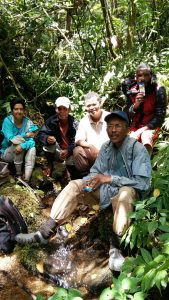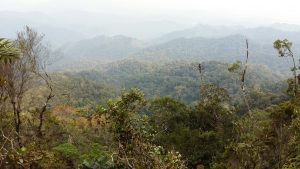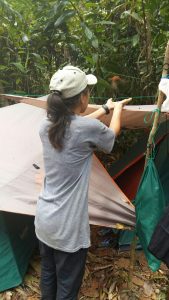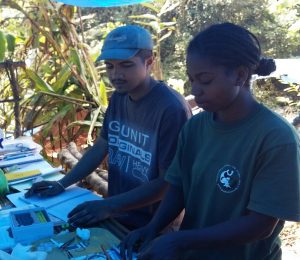In the Duke Lemur Center’s new “Notes from the Field” series, we follow DLC researcher and SAVA Conservation Project Coordinator Marina Blanco on a field expedition to Madagascar. This is the second entry in our multi-part series.
From Marina: An Introduction
We made it to camp with some delay. Weather has been fantastic but terrain is hard. I will leave it at that. Beautiful views from crests/summit. We have seen disturbance, including tons of snare traps. I saw silkies for the first time yesterday (everyone else had seen them before!).
We are healthy and in good spirits, but energy levels are going down a bit.
I’ve sent notes for the blog below. If I have enough reception, I’ll send photos too.
Many greetings,
m–

Surveying an area for our second camp: Marina, Victor (guide), Christian (herp specialist), Velomeva (guide), and Mihaja (bird specialist)
Research Methods & Goals
We are leaving campsite 1 at COMATSA corridor and approaching the middle of our mission.
The primary goal of our expedition, funded by a CFHF grant, is to assess biodiversity in birds, herps, micromammals, and lemurs in two sites surveyed 15 years ago by Steve Goodman’s team. We are using standard research methods, including diurnal and nocturnal surveys supplemented with captures using live traps, pitfall traps, and mist nets.
The Importance of Biodiversity Assessments
When we set up traps/nets, we are disrupting animals’ routines. But, while it may be a not-so-great day for the animals, it’s very worthwhile to make species visible and to know that they exist at a particular location. Daytime and nocturnal observations alone are often insufficient for species identification. Moreover, by collecting biological samples (by ear clips, for example), we can address questions about population structure/dynamics across sites.
Assessments of biodiversity are also important even beyond their scientific value. They can inform forest management programs. When we hear conservationists, researchers, and students say “we need to protect the biodiversity,” we tend to assume we know what’s out there to be protected — but for many sites, we just don’t know enough. Biological surveys can also help in conservation efforts by providing information about habitat quality and suggesting priority measures. For example, some species are characteristic of primary “undisturbed” forests, whereas others may be indicators of forest edges or clearings.
Observations
So far we have seen 6 lemurs species: Propithecus candidus (silky sifaka), Eulemur albifrons (white fronted lemur), Eulemur rubriventer (red bellied lemur), Microcebus sp. (mouse lemur), Cheirogaleus crossleyi (dwarf lemur), and Lepilemur seali (sportive lemur). In addition, we have seen more than 5 species of micromammals, 35 species of reptiles/amphibians, and around 50 species of birds.
We have witnessed some illegal activities, such as unauthorized logging and multiple snare traps for lemur hunting. Those observations will be included in our report to WWF, which manages COMATSA.
Notes on Bird Team
Manoa (bird team assistant) spent several minutes patiently freeing the velvet asity from the net. The little bird was the only unwilling visitor that afternoon, caught on the lowest panel of the mist net, hanging like a stuffed animal. I silently looked at her, the gentleness she displayed while trying to solve the puzzle of her entanglement. After that routine was done, the little bird was placed gently in a little bag to be carried to camp. Measurements and photos were to follow. Before we headed back, I said to Manoa: “Well, you have a special talent for this — I don’t think I could be that patient!” She looked at me while turning toward camp and said, “I love birds.” That simple answer makes sense: you do what it takes, including ending up in a remote forest location far away from home.
Notes on Micromammal Team
I’ve never met anyone so excited about rats! Njara (micromammal team assistant) took a peek inside the bag and her eyes brightened. The rat was endemic and it was big. Its tuft-tailed feature gave away its genus, Eliurus. The coloration, white at the tip, restricted the list of candidate species to only a few. The rainforest distribution further restricted it, this time to just to options. This rat, however, was bigger in all respects. Whether it was a large Eliurus tanala or something else would need to be determined later in the lab, but the excitement — the thrill of discovery — permeated the rest of Njara’s day. Njara is used to handling rats and tenrecs and dealing with claws and fierce behaviors. When handling animals, she’s equally at ease handling creatures from 50g to more than a kilo, from spiny Setifer setosus (the greater hedgehog tenrec) to aggressive Rattus rattus. I’m learning a lot from her! My experience with mouse and dwarf lemurs cannot compare to the large range of micromammal biodiversity Njara generally has to deal with.
Notes on Reptile/Amphibian Team
We crossed the little stream by the camp, our flashlights piercing the noisy darkness. I had an intent look and a predisposed attitude though little experience looking for herps (reptiles or amphibians). I love the night, and I’m quite accustomed to detecting eye shines — especially high in the canopy (where dwarf lemurs generally hang out). In fact, we proudly talk about neck pain after a walk, a sign we’ve tried hard to find Cheirogaleus! But this walk is different: it’s about focusing on different layers of the canopy, different depths of vision, different triggers for detection. A few sections after we started climbing the steep slope, Christian (herp team specialist) stopped and said “misy biby!” as he found a tiny chameleon. It took me more than a few seconds to actually see it, even after following his pointed finger. There were many more “misy biby” after that, including one from Ginah (herp team assistant) finding a leaf-tailed gecko (Uroplatus) more than 6m away from her. Just before we finished our productive night (despite my inability to see things), Christian said “Microcebus!” and I turned around and saw the unmistakable eye shine. With a smile, I thanked him for helping the lemur team; to which he replied, “Well, I am a biologist after all!”
For the previous installment, click here for Part I: A New & Exciting Research Challenge for DLC/SAVA Conservation.
For the next installment – and more gorgeous photos! – click here for Part III: Final Thoughts.




